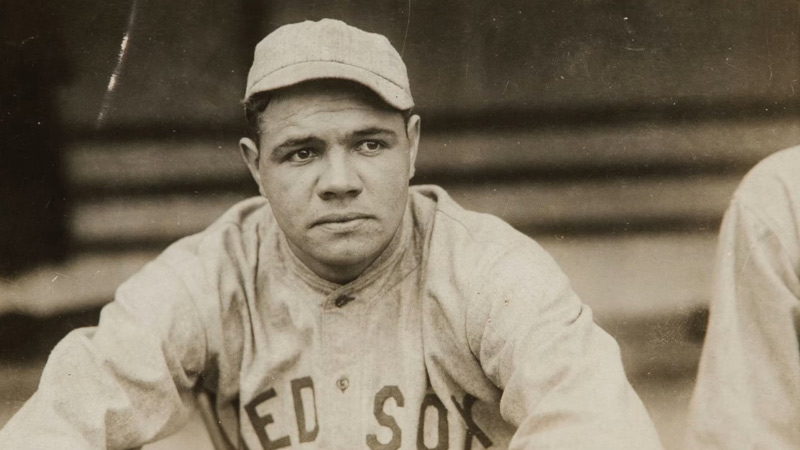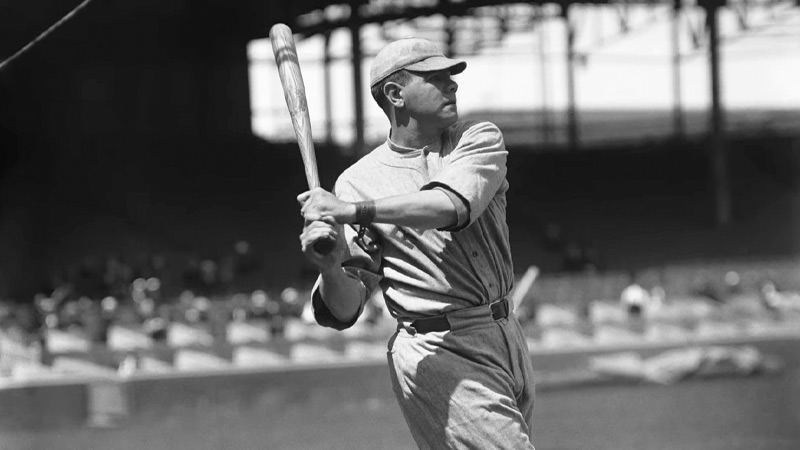Babe Ruth’s name is synonymous with baseball excellence, known for his legendary home runs and charismatic persona.
However, it’s easy to overlook his pitching prowess during the early years of his career.
In our exploration of the iconic Babe Ruth’s baseball journey, we delve into the question that has intrigued sports enthusiasts for decades: How fast did Babe Ruth throw?
Ruth’s transition from a powerful left-handed pitcher to a record-breaking batter reshaped the sport’s history.
Though the measurement tools of his time couldn’t precisely capture the speed of his pitches, historical accounts, and estimations offer valuable insights into his impressive fastball.
Join us as we uncover the significance of Ruth’s pitching speed, and how it contributed to his legendary status in the annals of baseball history. Stay focused.
Who Is Babe Ruth?
Babe Ruth, whose real name was George Herman Ruth, was an American professional baseball player who is often regarded as one of the greatest baseball players in history.
He was born on February 6, 1895, and passed away on August 16, 1948. Babe Ruth is primarily known for his prolific career as a Major League Baseball player, particularly with the New York Yankees.
Ruth began his career as a pitcher with the Boston Red Sox in 1914 but gained fame as an outfielder and a power hitter during his time with the New York Yankees, which spanned from 1920 to 1934.
He set numerous records during his career, including the single-season home run record. His ability to hit home runs and his charismatic personality made him a sports icon of his era.
Babe Ruth’s career accomplishments include 714 home runs, a record that stood for many years, and seven World Series championships.
His impact on the game of baseball was profound, and he remains a legendary figure in American sports history.
Babe Ruth was inducted into the Baseball Hall of Fame in 1936, and his name is synonymous with baseball excellence.
Why Is Babe Ruth So Popular?

Babe Ruth remains incredibly popular for several reasons:
Pioneering Power Hitting
Babe Ruth revolutionized the game of baseball with his remarkable power-hitting. His ability to consistently hit home runs on a scale never before seen made him an exciting and dynamic player to watch.
Ruth’s home run-hitting prowess captivated fans and changed the way the game was played, emphasizing the importance of power in a player’s skill set.
Charismatic Personality
Ruth’s larger-than-life personality and charisma endeared him to fans. He was known for his jovial and outgoing nature, both on and off the field.
His approachable demeanor and willingness to interact with fans made him a beloved figure, transcending baseball and becoming a popular cultural icon.
Record-Breaking Achievements
Babe Ruth set numerous records during his career, including the single-season home run record and the career home run record.
These achievements solidified his status as a sports legend. His records stood for decades, adding to his enduring popularity and legacy in the sport.
Transition to the New York Yankees
Babe Ruth’s move from the Boston Red Sox to the New York Yankees in 1920 was a pivotal moment in his career and in the history of baseball.
This transition marked the beginning of the Yankees’ dynasty and the birth of the “Yankees’ mystique.”
Ruth’s success with the Yankees and their subsequent dominance in the sport further elevated his status and contributed to the team’s enduring popularity.
How Fast Did Babe Ruth Throw?

There is always a public interest in how fast could Babe Ruth throw. Babe Ruth was primarily known for his hitting prowess rather than his pitching speed.
However, during his early career, when he was a pitcher for the Boston Red Sox, he could throw a fastball in the range of 90 to 95 miles per hour (about 145 to 153 kilometers per hour).
It’s important to note that the measurement of Babe Ruth’s pitch speeds during Ruth’s era was less precise than it is today, as modern technology like radar guns was not available.
Babe Ruth’s pitching record speed was considered impressive for his time, and he was a dominant left-handed pitcher before transitioning to become an outfielder and power hitter.
His impact as a pitcher was notable, but he is most famous for his hitting and home run records rather than his pitching speed.
Today, he is remembered more for his contributions as a slugger and an iconic figure in baseball history.
How Fast Did Babe Ruth’s Pitch
Babe Ruth began his professional baseball career as a pitcher with the Boston Red Sox in 1914.
During this period, Babe Ruth pitching record speed was estimated to be in the range of 90 to 95 miles per hour (about 145 to 153 kilometers per hour). He quickly gained a reputation as a formidable left-handed pitcher.
Transition to Outfield
Despite his success as a pitcher, Ruth’s hitting abilities and popularity as a batter eventually led to his transition to the outfield.
This transition marked a significant turning point in his career, and he became more renowned for his power-hitting rather than his pitching.
Historical Perspective
While Ruth’s pitching speed may not be as impressive when compared to modern pitchers, it was noteworthy in the context of the early 20th century.
He was one of the hardest-throwing pitchers of his time and made a substantial impact as a pitcher before transitioning to a position player.
Emphasis on Hitting
Babe Ruth’s legacy is primarily tied to his prolific hitting and his record-breaking home runs.
His transition to the outfield and his subsequent success as a power hitter contributed significantly to his enduring popularity in the world of baseball, overshadowing his pitching career.
How Hard Did Babe Ruth Pitch?

During his career as a pitcher, Babe Ruth was known for his impressive fastball velocity.
While precise speed measurements were not available at the time, it is estimated that he could throw a fastball in the range of 90 to 95 miles per hour (about 145 to 153 kilometers per hour).
These estimates are based on historical records and eyewitness accounts.
For His Era
Ruth’s pitching speed was considered exceptional for the era in which he played, which was the early 20th century.
He was one of the hardest-throwing pitchers of his time and struck fear into opposing batters with his velocity and intimidating presence on the mound.
Left-Handed Power
What made Ruth’s pitching even more remarkable was that he was a left-handed pitcher, and left-handed power pitchers were relatively rare in that era.
His ability to combine speed with his left-handed delivery made him a unique and dominant force on the mound.
Transition to Hitting
Despite his pitching success, Babe Ruth’s transition to the outfield and his incredible hitting abilities ultimately defined his legacy.
He became one of the most iconic power hitters in baseball history, setting numerous records, including the career home run record.
This transition shifted the focus away from his pitching and solidified his place as a baseball legend primarily for his batting prowess.
Significance of Babe Ruth in Baseball

Babe Ruth holds immense significance in the history of baseball for several reasons:
Revolutionizing the Game
Babe Ruth is often credited with changing the way baseball was played. He introduced the concept of power-hitting, emphasizing the home run as a critical offensive tool.
His ability to hit home runs in great numbers redefined the game’s strategy and increased its excitement.
Record-Breaking Achievements
Ruth set numerous records during his career, including the single-season home run record and the career home run record.
His records stood for many years and captured the imagination of baseball fans. His 714 career home runs remained the record for nearly four decades, emphasizing his significance in the sport’s history.
Popularizing the New York Yankees
Babe Ruth’s transfer to the New York Yankees in 1920 was a pivotal moment in both his career and the franchise’s history.
This marked the beginning of the Yankees’ dominance in baseball and solidified their status as one of the most popular and successful teams.
Ruth’s presence and success played a significant role in making the Yankees a baseball powerhouse.
Cultural Icon
Beyond baseball, Babe Ruth became a cultural icon. His charismatic personality, larger-than-life image, and engaging style endeared him to fans.
He transcended the sport, making him a symbol of American sports excellence and achievement.
Hall of Fame Induction
Babe Ruth was one of the first five players to be inducted into the Baseball Hall of Fame in 1936, underlining his status as one of the greatest players in the history of the game.
His induction further solidified his significance and lasting impact on baseball.
Legitimizing the Power Hitter
Babe Ruth demonstrated that power hitters could be successful and dominate the game. This influence is still seen in modern baseball, where power-hitting is highly valued, and home run records continue to be broken.
Babe Ruth’s impact on baseball is immeasurable.
FAQs
How fast did Babe Ruth throw?
Babe Ruth’s fastball was estimated to be in the range of 90 to 95 miles per hour, which was considered impressive during his era in the early 20th century.
How hard did Babe Ruth throw?
Ruth’s fastball velocity was estimated at 90 to 95 miles per hour, making him one of the hardest-throwing pitchers of his time.
How fast was Babe Ruth’s fastball?
Babe Ruth’s fastball typically reached speeds between 90 and 95 miles per hour during his pitching career.
What is the Babe Ruth fastest pitch?
While precise measurements were unavailable at the time, Babe Ruth’s fastest pitches were estimated to be in the range of 90 to 95 miles per hour, demonstrating his impressive velocity as a pitcher.
How fast did Babe Ruth pitch?
Babe Ruth’s pitching speed ranged from 90 to 95 miles per hour during his career, making him one of the most powerful and dominant pitchers of his era.
Wrapping Up
In retracing the baseball journey of Babe Ruth and unraveling the mystery of his pitching speed, we gain a deeper appreciation for his multifaceted talent.
Ruth’s estimated fastball velocity of 90 to 95 miles per hour, while modest by today’s standards, was groundbreaking in his era, establishing him as one of the most dominant pitchers.
Yet, it was his transition to a power-hitting outfielder that cemented his legacy. His ability to revolutionize the game through power-hitting, charismatic personality, and record-breaking achievements transcends time.
Babe Ruth remains an iconic figure not just in the world of baseball but in the larger tapestry of American sports history.
His significance endures, reminding us of the enduring impact of his incredible journey from the pitcher’s mound to the batter’s box. Thank you for your time.







